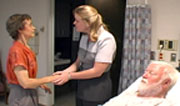 |
Evidence-Based
Practice |
Posing a Well-Built COPES Question and
Classifying It Into One of Five Question Types
The information contained in this website is copyrighted. It will appear
in the following book: Gibbs, L. (2003). Evidence-Based Practice for
the Helping Professions: A Practical Guide with Integrated Multimedia,
Pacific Grove, CA: Brooks/ Cole an Imprint of Wadsworth Publishers.
Brief
Overview
Learning how to pose a clearly-formulated or well-built question (Armstrong,1999;
McKibbon, Richardson & Walker-Dilks, 1999; Richardson, 1998, Richardson,
Wilson, Nishikawa, & Hayward, 1995) constitutes the very first step
in most detailed descriptions of evidence-based practice (Sackett et al.,
1997, 21-36).
Generating
COPES Questions
Client Oriented Practical Evidence Search (COPES) questions come directly
from practice. COPES questions have three general features. First, they
are questions from daily practice, posed by practitioners, that really
matter to the client’s welfare—they’re Client Oriented
(Here the word “client” refers to an individual, to a group
of clients, or to a community). They concern issues that are central to
the welfare of the client and to those whose lives are affected by the
client. Second, COPES questions have Practical importance in several
ways. They have practical significance if they concern problems
that arise frequently in everyday practice, if they concern the mission
of the agency, and if knowing the answer concerns something within the
realm of possibility; so knowing the answer could result in effective
use for their answer. Third, COPES questions are specific enough to guide
an electronic Evidence Search.
In order to be well-built enough to guide an evidence search, a question should include elements that are listed vertically in the table below. COPES questions generally fall into five categories that are also listed in the table below. To complete your COPES question, fill in the bottom boxes in the table below.
Five
COPES Question Types and Four Corresponding Features of a Well-Built Question
| Client Type and Problem | What You Might Do | Alternate Course of Action | What You Want to Accomplish | |
|
Across: Four Elements In a Well-Formulated Question _________ Down: Five Question Types |
How would I describe a group of clients of similar type. Be specific. | Apply a treatment; act to prevent a problem; measure to assess a problem; survey clients; screen clients to assess risk | What is the main alternative other than in the box to the left? Do nothing? Apply another intervention? Apply another risk assessment scale? | Outcome of treatment or prevention? Valid measure? Accurate Risk Estimation, Prevented Behavior, Accurate Estimation of Need |
| Example Effectiveness Q. (See above) | If disoriented aged persons who reside in a nursing home Are given Reality Orientation Therapy | Are given Reality Orientation Therapy | Or Validation Therapy | Which will result in Better Orientation to Time, Place, Person? |
| Example Prevention Q. (See above) | If sexually active high school students at high risk for pregnancy | Are exposed to Baby-Think-It-Over | Or to Didactic Material on Proper Use of Birth Control Methods | Then will the former have Fewer Pregnancies During an Academic Year, Knowledge of Birth Control Methods, Use Birth Control Methods? |
| Example Assessment Q. (See above) | If aged residents of a nursing home who may be depressed or may have Alzheimer’s Disease or Dementia | Are administered Depression Screening Tests | Or a Short Mental Status Examination Tests | Which will measure will be the Briefest, Most Inexpensive, Valid and Reliable Screening Test to Discriminate Between Depression and Dementia? |
| Example
Description Q. (See above) |
If family members of persons diagnosed with Aphasia meet in a support group | And receive a Short Client Satisfaction Questionnaire of all support group participants | Which will the clients list as their area of Areas Of Greatest and Least Satisfaction? | |
| Example Risk Q. (See above) | If crisis line callers to a battered women shelter | Are administered a risk assessment scale by telephone | Or we rely on practical judgment unaided by a risk assessment scale | Then will the Risk Assessment Scale have higher reliability and predictive validity regarding Future Violence? |
| Determine
Your Question Type, Then Insert Elements of Your Question in Spaces on Right Question Type _____________ |
This table follows Sackett, D. L., Richardson, W. S., Rosenberg, W., & Haynes, R. B. (1997). Evidence-based Medicine: How to practice and teach EBM. New York: Churchill Livingstone. Adapted with permission.